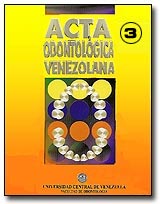EMPLEO DE LA EDAD DENTAL Y LA EDAD OSEA PARA EL CÁLCULO DE LA EDAD CRONOLÓGICA CON FINES FORENSES, EN NIÑOS ESCOLARES CON ALTERACIONES EN EL ESTADO NUTRICIONAL, EN MARACAIBO, ESTADO ZULIA - Estudio preliminar
Palabras clave:
Edad cronológica, edad dental, edad ósea, Odontología Forense, talla y peso altos, talla y peso bajos, chronological age, dental age, skeletal age, Forensic Dentistry, high size and weight, low size, weightResumen
Esta investigación tiene como objetivo determinar si las alteraciones en los valores de peso y talla afectan el cálculo de la edad dental y esqueletal en niños escolares en Maracaibo, Estado Zulia, a fin de determinar la edad cronológica de los niños en casos de desastres o accidentes. Se realizó un estudio clínico exploratorio, en 60 niños: 1) Grupo experimental: 15 con indicadores antropométricos de desnutrición y 15 con indicadores antropométricos de obesidad; y 2) Grupo control: 30 niños con talla y peso acordes a su edad cronológica y sexo. Se aplicó el método de Demirjian y cols., para estimar la edad dental y el método de Greulich y Pyle para calcular la edad ósea. Se obtuvo que el promedio de la edad dental fue mayor que el de la edad cronológica y la edad ósea, en el total de la muestra. La media de la edad dental fue 1,52 y 0,34 años menor en los niños con talla y peso bajos, al ser comparada con el control y con los niños de talla y peso altos para su edad cronológica y sexo. La media de la edad ósea de los niños con talla y peso bajos fue de 1,72 y 2,05 años menor, en comparación con la media de la edad ósea de los niños de talla y peso acordes, y de los niños con talla y peso altos para su edad cronológica y sexo, respectivamente. Se observó un posible efecto de la nutrición sobre la edad dental. Se comprobó que la edad ósea es afectada por el estado nutricional. La combinación de las variables edad ósea y edad dental representa una mejoría significativa en la predicción de la edad cronológica, independientemente del estado nutricional.ABSTRACT
The aim of this paper was to determine if the alterations in values of size and weight affect the estimation of dental and skeletal ages in scholar children in Maracaibo, Zulia State. A clinical, explorative study was carried out, in a sample of 60 children: 1) Experimental group: 15 with anthropometric signs of undernourishment and 15 with anthropometric signs of obesity; y 2) Control group: 30 children with size and weight according to their chronological ages. The Demirjian et al. method was applied in order to determine the dental age and the Greulich-Pyle method to estimate the skeletal age. The total sample exhibited a mean of dental age higher than the chronological and skeletal ages. The mean of the dental age was 1,54 and 0,34 years less in children with low size and weight, by comparing to the control group and the group of children with high size and weight related to their chronological age and sex. The mean of skeletal age in children with low size and weight was 1,72 and 2,05 years less, by comparing to the mean of skeletal age in control children, and children with high size and weight related to their chronological age and sex, respectively. It was observed a possible effect of the nutrition on the dental age. It was confirmed that the skeletal age is affected by the nutritional status. The combination of the variables skeletal age and dental age represents a significant improvement in order to predict the chronological age, regardless of the nutritional status.
Descargas
Los datos de descargas todavía no están disponibles.


